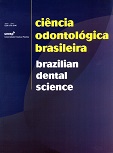Avaliação da solução de clorexidina 2% e medicamentos sobre Escherichia coli e sua endotoxina em canais radiculares.
DOI:
https://doi.org/10.14295/bds.2009.v12i3.631Abstract
A proposta deste estudo foi avaliar a efetividade da solução de clorexidina 2% e medicações intracanais sobre Eschericha coli e endotoxina em canais radiculares. Os canais radiculares de 48 dentes unirradiculados foram contaminados com E. coli por 14 dias, instrumentados com solução de clorexidina 2% e divididos em 3 grupos de acordo com a medicação intracanal (MIC) utilizada: pasta de Ca(OH)2, polimixina B, Ca(OH)2 + clorexidina gel 2% (CLX). No grupo controle foi utilizada somente solução fisiológica. Foram realizadas coletas do conteúdo do canal radicular imediatamente após a instrumentação (S1), após 7 dias da instrumentação (S2), imediatamente após 14 dias da ação da MIC (S3) e 7 dias após remoção da MIC (S4). Para todas as coletas foram realizados os seguintes testes: a) análise microbiológica; b) quantificação de endotoxina pelo teste cromogênico do lisado de amebócitos do Limulus. Os resultados foram analisados pelo teste de ANOVA e Dunn (5%). Na amostra S2 a sol. CLX 2% apresentou melhores resultados em relação à solução fisiológica. Na amostra S3 houve diferença estatística do Ca(OH)2 + CLX em relação ao Ca(OH)2 e polimixina B. Na amostra S4 não houve diferenças estatísticas significantes entre os grupos. Conclui-se que somente as medicações intracanais são capazes de diminuir significativamente a quantidade de endotoxinas.
Downloads
Downloads
Published
How to Cite
Issue
Section
License
Brazilian Dental Science uses the Creative Commons (CC-BY 4.0) license, thus preserving the integrity of articles in an open access environment. The journal allows the author to retain publishing rights without restrictions.
=================




























